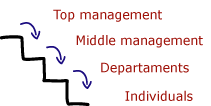Keys to develop a strategic plan
1. We need to define a strategy! It seems rather obvious, but most people and organisations act by habit, with little coordination or undefined plans.
2. A plan only makes sense if embedded in two poles (Intention and Vision). We need clearly defined targets, before the strategy can be defined. Temptation is huge to act imediately. It takes training to first establish goals. People and organisations tend to be task oriented and thus waste their energy. In military terms it would mean taking 2000 shots at a single target or bombing a whole country to find one person. The strategy is wrong and ineffective.
 3. In organisations the strategy needs to cascade down. Frequently a board member's new input unleashes an uncontrolled movement of busy-ness in an organisation. Probably the most difficult part of a good strategic plan is to carry it to each organisational level without skipping any intermediate step. To insure coherence, it needs to unfold downwards with clear goals on each level, each building on the previous one. 3. In organisations the strategy needs to cascade down. Frequently a board member's new input unleashes an uncontrolled movement of busy-ness in an organisation. Probably the most difficult part of a good strategic plan is to carry it to each organisational level without skipping any intermediate step. To insure coherence, it needs to unfold downwards with clear goals on each level, each building on the previous one.
4. The easiest way to get people to support an action plan is to have them participate in its making. To follow set instructions is under demanding. Having contributed to a plan generates a special commitment for its implementation. Graphic facilitation is a powerful tool to achieve just that.
5.
A plan is easier to carry when in the early stages of its development goals and tasks are matched with the existing organisational structure, i.e. projects and responsibilities get defined so that departments can execute them on their own. Cross-departmental projects should be minimized.
6. Nothing happens without clearly defined responsibilities and deadlines: who does what by when.
7. The ultimate link in the chain of a strategic plan is the follow-through of individual tasks through appraisal interviews or similar means. A plan materialises only when individuals do their job.
8. To monitor a plan, fulfil intermediate milestones, celebrate success and communicate well its evolution generate the strength to carry on. |










